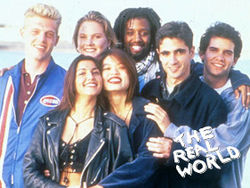The 28th season of The Real World premieres tonight, and the trailer features some crying bros and a lot of slapping in Portland, Ore. To remind us of the show’s less … well, shitty origins, MTV ran a “retro marathon” of its first three seasons last weekend.
Before the Teen Mom franchise, before Jersey Shore (and its ever-multiplying spin-offs), and before something called Buckwild that I don’t feel like researching, there were true stories of seven strangers picked to live in houses in New York and Los Angeles. And then in 1994, some strangers came to the wonderful city of San Francisco. The third season, last weekend’s grand finale, often gets credited with sparking the show’s popularity and indirectly launching the reality TV craze. It almost lives up to its reputation.
Usually, watching a reality television show after it’s finished airing presents a predicament; the knowledge that the cast has returned to the world outside the screen takes away the precept — flimsy as it is to begin with — that we are seeing reality unfold. Watching the San Francisco season is a different experience. The 19 years of distance, a huge cultural gap (OMG, no smartphones!), makes the show a historical document.
The Real World: San Francisco is a fascinating record of 20-something life in the mid-90s (OMG, no texting!). And because at that time, the channel dealt with issues besides teen pregnancy, it’s also a depiction of an earlier era of gay rights, of a different political climate, and of a time when an AIDS educator had to reassure his peers that they did not need to fear sharing a bathroom with someone HIV-positive.
Pedro Zamora, one of the first openly gay and HIV-positive men on TV, has been tasked with the responsibility of giving a face to history (the use of B-roll that supplements parts of his story, such as his emigration from Cuba, adds to the sense of his role in the show as documentary). Bill Clinton, who took up the cause of honoring Zamora, believed his stint on The Real World made giant strides in the effort to humanize the struggle with HIV/AIDS and that lends great historical weight to the show.
So, counter to the typical experience of re-watching reality TV, our awareness of events after San Francisco heightens the drama. Knowledge of Pedro’s death right after the season’s premier gives his plotline — for lack of a better term — an eery poignancy. On a happier note, Pam Ling and Judd Winick’s marriage in 2001 their season makes us look for clues in their innocent beginnings as friends during taping. The show becomes primary source material for their romance. Less pleasant is the tale of Puck (David Rainey), the roommate kicked out of the house, whose life after the show comes as no surprise at all. (Don’t worry, he got out of jail in time to film this interview before the marathon.)
How can any reality show claim to show an authentic view of history, though? It probably can’t, but It’s worth noting that The Real World‘s claim to be a social experiment had some legitimacy back then; people didn’t sign up for reality TV to achieve the same fame that they do today because the cult of the reality TV star had not yet exploded (in 1994, Kim Kardashian was still in the early stages of puberty). As a result, most of the cast was intelligent and had real goals that made them compelling and seemingly genuine. (We do, however, find a proto-reality TV star in Rachel Campos, the pretty girl who gave up dreams of academia when she met her husband on Road Rules: All Stars. For a while, she occasionally guest-hosted The View, and her Wikipedia page lists her occupation as “television personality.”)
Much of what makes The Real World: San Francisco entertaining nearly two decades later, though, are the things that make all ‘90s artifacts entertaining. It is a history of those fun outdated cultural signs that make “Buzzfeed Rewind” slide shows so heartwarming for millennials. Look at the low resolution! Note the light wash high-waisted jeans worn by men and women alike! Everyone’s rollerblading! Remember pagers?
And don’t worry, there are the requisite black-and-white confessionals, a comically suggestive musical score, and some drama, too — yelling, making out (and subsequent regret), and name-calling. But a word of warning for fans of Bad Girls Club and Tila Tequila: the name-calling doesn’t get much worse than “brat.”
Which brings me to a final point that, yes, the show mostly lives up to its reputation; The Real World: San Francisco is compelling as a historical record and nostalgia machine, but I have to admit that overall, I found it a little bland. The cast has a good time together, argues about house cleanliness over the dinner table, and learns from each other, but the fact that one of the few drunken escapades happens as a ladies’ night in floral pajamas made the whole day-to-day feel a little too charming.
It’s official: today’s television has ruined me. I don’t want to see interesting people with ambitious goals or downtrodden youth with the passion to make society more tolerant. I don’t want a document of reality at all, but an absurd heightening of it.
Even so, I think I’ll probably skip The Real World: Portland.
Oh, and if you want your own fix of retro reality, you can stream the complete San Francisco season here.

